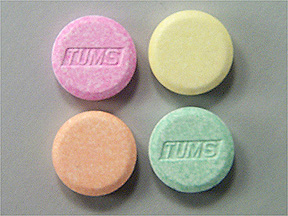Tums Regular Strength and Alcohol/Food Interactions
There is 1 alcohol/food/lifestyle interaction with Tums Regular Strength (calcium carbonate).
Calcium Carbonate Food/Lifestyle
Moderate Food Interaction
ADJUST DOSING INTERVAL: Administration with food may increase the absorption of calcium. However, foods high in oxalic acid (spinach or rhubarb), or phytic acid (bran and whole grains) may decrease calcium absorption.
MANAGEMENT: Calcium may be administered with food to increase absorption. Consider withholding calcium administration for at least 2 hours before or after consuming foods high in oxalic acid or phytic acid.
References (6)
- Cerner Multum, Inc. "UK Summary of Product Characteristics."
- Canadian Pharmacists Association (2006) e-CPS. http://www.pharmacists.ca/function/Subscriptions/ecps.cfm?link=eCPS_quikLink
- Cerner Multum, Inc. "Australian Product Information."
- Agencia Española de Medicamentos y Productos Sanitarios Healthcare (2008) Centro de información online de medicamentos de la AEMPS - CIMA. https://cima.aemps.es/cima/publico/home.html
- Mangels AR (2014) "Bone nutrients for vegetarians." Am J Clin Nutr, 100, epub
- Davies NT (1979) "Anti-nutrient factors affecting mineral utilization." Proc Nutr Soc, 38, p. 121-8
Switch to consumer interaction data
Tums Regular Strength drug interactions
There are 225 drug interactions with Tums Regular Strength (calcium carbonate).
Tums Regular Strength disease interactions
There are 5 disease interactions with Tums Regular Strength (calcium carbonate) which include:
More about Tums Regular Strength (calcium carbonate)
- Tums Regular Strength consumer information
- Check interactions
- Compare alternatives
- Pricing & coupons
- Reviews (5)
- Drug images
- Side effects
- Dosage information
- During pregnancy
- Support group
- Drug class: antacids
- En español
Related treatment guides
Drug Interaction Classification
| Highly clinically significant. Avoid combinations; the risk of the interaction outweighs the benefit. | |
| Moderately clinically significant. Usually avoid combinations; use it only under special circumstances. | |
| Minimally clinically significant. Minimize risk; assess risk and consider an alternative drug, take steps to circumvent the interaction risk and/or institute a monitoring plan. | |
| No interaction information available. |
See also:
Further information
Always consult your healthcare provider to ensure the information displayed on this page applies to your personal circumstances.


